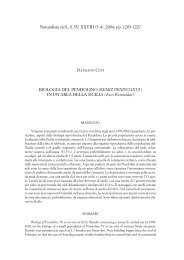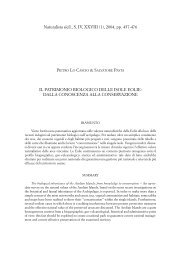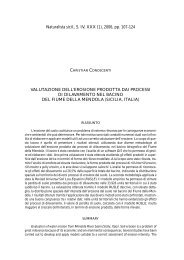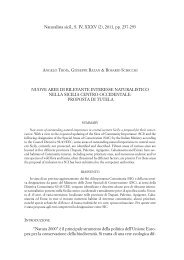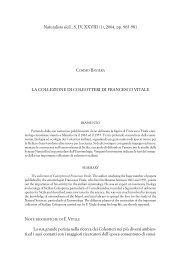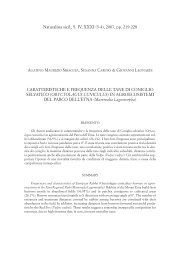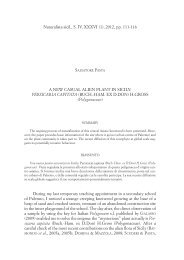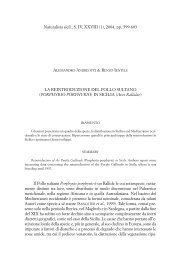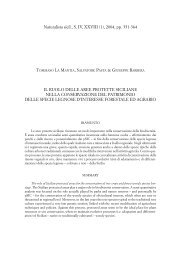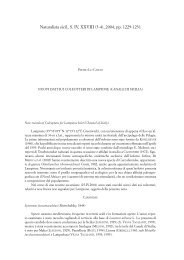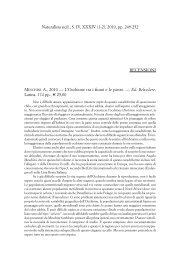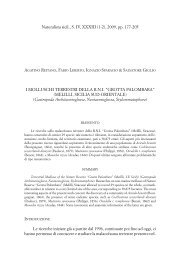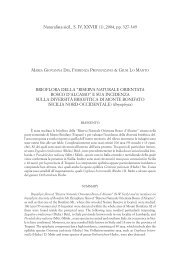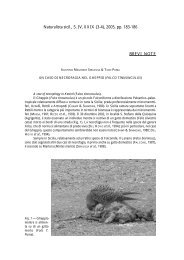2007,pp - Società Siciliana di Scienze Naturali
2007,pp - Società Siciliana di Scienze Naturali
2007,pp - Società Siciliana di Scienze Naturali
Create successful ePaper yourself
Turn your PDF publications into a flip-book with our unique Google optimized e-Paper software.
Gall midges (Diptera Cecidomyiidae) of Sicily<br />
RELATIONS OF GALL MIDGES WITH THEIR HOST PLANTS<br />
295<br />
The fauna of gall midges of Sicily may be considered as very rich in comparison<br />
with the gall midge fauna of other Me<strong>di</strong>terranean islands. In Sar<strong>di</strong>nia<br />
44 gall midge species are currently known (SKUHRAVÁ & SKUHRAVY´, 2002),<br />
while in Malta 36 (SKUHRAVÁ et al., 2002), in Crete 38 (SKUHRAVÁ &<br />
SKUHRAVY´, 1997), in Mallorca 33 species (SKUHRAVÁ & SKUHRAVY´, 2004), 49<br />
in Corfu, 33 in Samos (SKUHRAVÁ & SKUHRAVY´, 2006) and only 30 in Cyprus<br />
(SKUHRAVÁ & SKUHRAVY´, 2004). The gall midge species richness in Sicily is<br />
probably influenced by the richness of plant species growing in various plant<br />
associations from sea level up to mountains, by the size and geographical<br />
position of Sicily, but also possibly by its old entomological tra<strong>di</strong>tion, particularly<br />
for the presence of Teodosio De Stefani Perez, who intensively stu<strong>di</strong>ed<br />
gall midges and wasps for a time longer than 20 years.<br />
Sicilian flora consists of 2793 species belonging to 864 genera and 158<br />
families; as regards plant species, Sicily is one of the richest Italian regions<br />
(CONTI et al., 2005a, 2005b). Considering that Sicilian cecidofauna represents<br />
c. 18% of Italian one, while Sicilian flora represents the high figure of 41.6%<br />
of Italian one, it seems likely that future researches will increase the total<br />
amount of gall midge species living in the island. Furthermore, the fact that<br />
Sar<strong>di</strong>nian flora consists of 2295 species belonging to 782 genera and 159 families,<br />
while the number of gall midge species recorded in Sar<strong>di</strong>nia is half of<br />
that one of Sicily, is probably due to the lack of specific long-term researches<br />
in Sar<strong>di</strong>nia or to the higher island isolation causing lower species richness; as<br />
well, on Crete are known 1742 plant species belonging to 623 genera and 128<br />
families (CHILTON & TURLAND, 1997), while the gall midge species currently<br />
known are only 38. It seems evident that further researches on Cecidomyiidae<br />
are needed to reach a better picture of the actual number of species living on<br />
Me<strong>di</strong>terranean islands.<br />
In Sicily 89 gall midge species are associated with 77 host plant species,<br />
that is to say one gall midge species is associated with 1.16 host plant species.<br />
Only few plant species host more than two gall midge species, as for example<br />
Olea europaea and Quercus ilex, each hosting four gall midge species, Atriplex<br />
halimus and Vitis vinifera, each hosting three gall midge species, and Phillyrea<br />
me<strong>di</strong>a two species.<br />
On the other hand, most of gall midge species are monophagous and<br />
their larvae develop on only one plant species. Few gall midge species are<br />
oligophagous and their larvae may develop on two, three or more species of<br />
one genus of the host plant, as for example Dasineura rosae. Lasioptera<br />
carophila and Kiefferia pericarpiicola are polyphagous and may develop on<br />
many species and genera of the family Apiaceae. Asphondylia genna<strong>di</strong>i is con-



